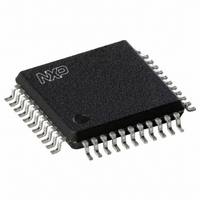OM4068H/2,518 NXP Semiconductors, OM4068H/2,518 Datasheet - Page 24

OM4068H/2,518
Manufacturer Part Number
OM4068H/2,518
Description
IC LCD DRIVER 44-QFP
Manufacturer
NXP Semiconductors
Datasheet
1.OM4068H2518.pdf
(28 pages)
Specifications of OM4068H/2,518
Package / Case
44-MQFP, 44-PQFP
Display Type
LCD
Configuration
32 Segment
Interface
Serial
Current - Supply
12µA
Voltage - Supply
2.5 V ~ 5.5 V
Operating Temperature
-40°C ~ 105°C
Mounting Type
Surface Mount
Number Of Digits
12
Number Of Segments
96
Maximum Clock Frequency
2.1 MHz
Operating Supply Voltage
2.5 V to 5.5 V
Maximum Power Dissipation
500 mW
Maximum Operating Temperature
+ 105 C
Attached Touch Screen
No
Maximum Supply Current
25 uA
Minimum Operating Temperature
- 40 C
Lead Free Status / RoHS Status
Lead free / RoHS Compliant
Digits Or Characters
-
Lead Free Status / Rohs Status
Lead free / RoHS Compliant
Other names
568-4513-2
935276329518
OM4068HB-T
OM4068HB-T
935276329518
OM4068HB-T
OM4068HB-T
Available stocks
Company
Part Number
Manufacturer
Quantity
Price
Company:
Part Number:
OM4068H/2,518
Manufacturer:
NXP Semiconductors
Quantity:
10 000
Philips Semiconductors
SOLDERING
Introduction
There is no soldering method that is ideal for all IC
packages. Wave soldering is often preferred when
through-hole and surface mounted components are mixed
on one printed-circuit board. However, wave soldering is
not always suitable for surface mounted ICs, or for
printed-circuits with high population densities. In these
situations reflow soldering is often used.
This text gives a very brief insight to a complex technology.
A more in-depth account of soldering ICs can be found in
our “Data Handbook IC26; Integrated Circuit Packages”
(order code 9398 652 90011).
DIP
S
The maximum permissible temperature of the solder is
260 C; solder at this temperature must not be in contact
with the joint for more than 5 seconds. The total contact
time of successive solder waves must not exceed
5 seconds.
The device may be mounted up to the seating plane, but
the temperature of the plastic body must not exceed the
specified maximum storage temperature (T
printed-circuit board has been pre-heated, forced cooling
may be necessary immediately after soldering to keep the
temperature within the permissible limit.
R
Apply a low voltage soldering iron (less than 24 V) to the
lead(s) of the package, below the seating plane or not
more than 2 mm above it. If the temperature of the
soldering iron bit is less than 300 C it may remain in
contact for up to 10 seconds. If the bit temperature is
between 300 and 400 C, contact may be up to 5 seconds.
QFP
R
Reflow soldering techniques are suitable for all QFP
packages.
1998 Jun 18
OLDERING BY DIPPING OR BY WAVE
EPAIRING SOLDERED JOINTS
EFLOW SOLDERING
LCD driver for low multiplex rates
stg max
). If the
24
The choice of heating method may be influenced by larger
plastic QFP packages (44 leads, or more). If infrared or
vapour phase heating is used and the large packages are
not absolutely dry (less than 0.1% moisture content by
weight), vaporization of the small amount of moisture in
them can cause cracking of the plastic body. For details,
refer to the Drypack information in the “Data Handbook
IC26; Integrated Circuit Packages; Section: Packing
Methods” .
Reflow soldering requires solder paste (a suspension of
fine solder particles, flux and binding agent) to be applied
to the printed-circuit board by screen printing, stencilling or
pressure-syringe dispensing before package placement.
Several methods exist for reflowing; for example,
infrared/convection heating in a conveyor type oven.
Throughput times (preheating, soldering and cooling) vary
between 50 and 300 seconds depending on heating
method. Typical reflow peak temperatures range from
215 to 250 C.
W
Wave soldering is not recommended for QFP packages.
This is because of the likelihood of solder bridging due to
closely-spaced leads and the possibility of incomplete
solder penetration in multi-lead devices.
If wave soldering cannot be avoided, for QFP
packages with a pitch (e) larger than 0.5 mm, the
following conditions must be observed:
Wave soldering is NOT applicable for all QFP
packages with a pitch (e) equal or less than 0.5 mm.
AVE SOLDERING
A double-wave (a turbulent wave with high upward
pressure followed by a smooth laminar wave)
soldering technique should be used.
The footprint must be at an angle of 45 to the board
direction and must incorporate solder thieves
downstream and at the side corners.
CAUTION
Product specification
OM4068














